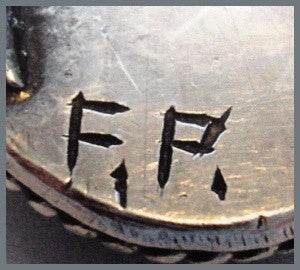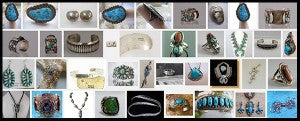Part 1
What is a Hallmark?
Hallmarks identify the jewelry maker. Many times they are just simple letter stamps. They are not something new, but can be traced back to the 4th Century. Famous American metal smiths used them before we became a country. Paul Revere who warned the Colonial militia “the British are coming” during the American Revolution used a hallmark on his handmade silver pieces in the 1700s.
The Navajo wouldn’t learn to make silver jewelry for another century after Paul Revere warned of the British invasion. It would be another 100 years after that before it was common for Navajo silversmiths to use a hallmark. Of course there are some exceptions, and some artists adopted the use of a hallmark in the early 20th century. However, those instances are very rare and we do not see a surge in Native American hallmarks until the 1970s and beyond.
Today a hallmark is seen as a badge of honor, and in fact it is exactly what collectors hunt for in our cases. You see buyers turn over certain pieces in our vintage cases looking for hard to find Kenneth Begay, Fred Peshlakai, Gibson Nez and other legendary artists works’. All of today’s well-known artists use a hallmark to identify their work. However, in the early days of hallmarks it was more about being Indian Handmade or the shop the work came out of, not the individual artist.
Mass producers like Fred Harvey and Maurice Maisel incorporated hallmarks identifying their brand early on. The problem was a lot of the time they would not be using Native American artists to make their Indian-style jewelry. That would lead to an effort to end non-Indian made Indian style jewelry. You would start to see US-Navajo stamps in the 1930s, and these would later be followed by IHM (Indian Handmade), IHMSS (Indian Handmade Sterling Silver) marks. Things would start to change as quality was encouraged, and Native American artists developed their own style and collectors would become more educated in relation to Indian handmade art.
We explore more hallmarks and their usage in Part II.
Part II
Who made my bracelet?
In an interview with Navajo artist Chester Kahn he suggests that it was unlikely you could afford to work as a silversmith fulltime when he first started making jewelry in the 1960s. When John Adair interviewed Tom Burnside in the 1940s for his book Navajo & Pueblo Silversmiths, Mr. Burnside makes the same suggestion. Even today it would be uncommon to see a fulltime silversmith not supplement his income with some other type of work. Well-known and award-winning Zuni artist Edith Tsabetsaye raises cattle that she sells at auction.
It doesn’t have to be a full-time artist that works part-time at something else. In fact, most of the time it is someone who works fulltime at something besides jewelry making that supplements his or her income with silversmithing. Many part-time silversmiths will use letter stamps for their hallmark, which can make it very difficult to identify the artist.
Artists like Orville Tsinnie make jewelry full-time, and Orville has created a very detailed hallmark to stamp his work with. His hallmark includes his full name along with the famous shape of Shiprock with the wording New Mexico. It is a complicated hallmark that is probably ordered from a supply house like Thunderbird or Indian Jewelry Supply. When a hallmark stamp is ordered it can take over a month to get and they are not cheap. Some artists will make their own hallmark stamp, and eventually the hallmark stamp will break or fade out. That means an artist might have several hallmarks over a course of his/her career.
Many part-time silversmiths do not want to invest the money or time to acquire a unique hallmark. Of course dealers want to buy pieces of jewelry that have a hallmark on them, and that is because buyers want a hallmark to authentic Native American jewelry they have purchased. An easy fix is a letter stamp that can be easily purchased for under $10. One letter stamp for your first name and another for your last name and that is all you need to create your not so unique hallmark.
Now, consider the style of Navajo jewelry. Many of the pieces have very similar looks and have been made by a number of different silversmiths. Also, consider the 1970s and 1980s when Navajo jewelry was in high demand. This was a time period when literally everyone in the family was making jewelry, and a lot of those silversmiths used initials for their hallmark. Many buyers do not realize how many Navajo silversmiths there are, and that alone makes identification very difficult if the work does not have a recognized hallmark.
In Part III we learn how to be a hallmark detective, it will be fun.
Part III
Resources to help you identify hallmarks
The question everyone wants to know is “who made my piece of jewelry”? We get asked this question frequently, and always approach it the same if we don’t know the answer.
We use a series of books:
I find this hallmark book the easiest to use. In the back of the book the hallmarks are listed alphabetically, which really makes life easy. It also has a useful list of shop marks, which is surprisingly helpful. The downfall is the 2nd Revision of this book was done in 2000 and that means a lot of new artists are not going to be in this publication.
This series of books (three volumes) can be really useful. First, Schaff includes lots of pictures so you are able to compare styles of art. Second, these publications are full artists given you many chances to find the correct hallmark and artist. Last, he provides a detailed description of each hallmark the artist has used over their career.
This book is filled with images of hallmarks, and that is very useful. What makes this a difficult book to use is you really need to know the name of the artist to make this book work efficiently.
If we believe the piece we are identifying is Hopi made we will use this book first. It is easy to use and has an extensive list of Hopi artists. Like the “Hallmarks of the Southwest” this book will not have the newer artists. The last time this book was updated was 1989.
We use the internet:
These two choices are quick if you have internet access. Like the books the internet doesn’t always get it right. It is in your best interest to use a combination of sources to make sure you have the right name associated with the hallmark you are researching.
I previously mentioned to you how many Navajo, Zuni & Hopi people are involved in jewelry making. This makes it impossible to know all of the different silversmiths. However, the ones who are active will be the easiest to identify, and that is a good reason to post your unknown hallmark on turquoisepeople.com. This is a community of Native American art enthusiasts who want to learn more.
In Part IV I will answer a question on turquoisepeople.com using these tools.
Part IV
Research Example, How we identify Hallmarks
This following question was posted on turquoisepeople.com.
Lets work through this identification question together. First, we will approach this question like we only have the Internet to use for a resource.
I am going to make some general assumptions about the two pieces. I believe that they are both Navajo made due to the style, and also going to age them back to the 1970s – 80s.
Next, go to the http://www.art-amerindien.com/signature_bijoux_amerindiens.htm site. The ring has a very clear hallmark, letters JT inside a box. You will find you search by first initial on the hallmark site, so we click the J. When we get to the JT section we find several marks, but none of them have the box around them. Fight the temptation to think one of the JT’s is your artist, this is a very distinct hallmark and most likely doesn’t belong to one of the artists listed.
Now we will turn to Google, the massive search engine. I will conduct a couple of searches using the search terms, “Navajo Hallmark JT”, “Navajo Jewelry JT”. Also, I will do the search under images. I do this because it is much more useful than the web setting. After checking a few of the pictures I do not find what I am looking for, and a quick visual scan of the page doesn’t reveal anything promising. With two Internet strikeouts I will turn to the books.
My go to book is Wright’s Hallmarks of the Southwest. I immediately flip to the back of the book to Index I. Six JT hallmarks are listed, but none with the box around them. Before I begin googling the names associated with the JT hallmarks I turn to Hougart’s Native American and Southwestern Silver Hallmarks. The book is not as easy to use as Wright’s work, but it has lots of images. The book goes by artist’s last name, so I turn to the Ts. I come across a promising picture, and the name associated with the hallmark is Johnson Todacheeny.
I do a Google image search “Johnson Todacheeny White Hogan” to reveal that Johnson Todacheeny appears to be the right name. Turns out he was a silversmith for White Hogan, the shop associated with the “Father of Modern Navajo jewelry” Kenneth Begay.
Many times artists who worked before the age of the Internet (1995ish) can have a very limited presence on the web. Just like we saw with Johnson Todacheeny. Also, I went back to the Hallmarks of the Southwest and found Johnson’s name associated with one of the JT stamped hallmarks, but it did not have the box around it.
Now that you know the process try to figure out the hallmark associated with the turquoise and coral bracelet. This appears to be more of a symbol, instead of initials, good luck. Share your thoughts on turquoisepeople.com, and remember you can find several unanswered questions here which makes great practice.
If you have any questions or comments please email me at jason@perrynulltrading.com























I have a turquoise ring purchased many years ago on a trip thru the southwest. Do these marks I D the ring? WM SS WHN and the numbers 0042A “scratched” on the back. After about 50 years I am curious.
If you have the time to bother with this, I thank you very much in advance!
I have a silver necklace with X on the back
Hello, I was just gifted a large serling arrow pin, I think it’s Navajo. it’s stamped JLG. at the website you direct us to I have looked, and of all the J signatures they have, the only one they have question marks for is JLG. do you know who JLG is?
thank you.